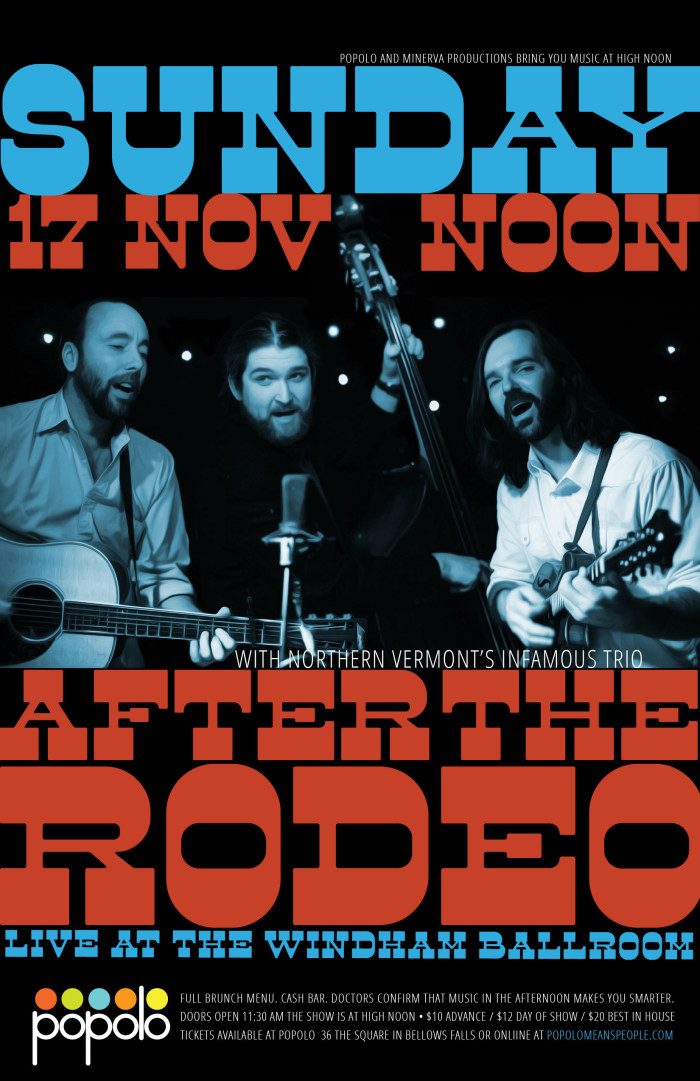36 THE SQUARE BELLOWS FALLS, VT 05101 RESERVATIONS BY PHONE ONLY 802.460.7676 POPOLOMEANS@GMAIL.COM JOIN OUR MAILING LIST |
|
||
| employment and training | |||
The Windham Ballroom | 40 The Square | Bellows Falls, VT
This trio of musical alchemists from ’round Burlington way blend Americana, Jazz, Blues, and Bluegrass with a stunning vocal facility to make something perfect for a Sunday Afternoon.
You Can And Should See After The Rodeo
The considered life is often a battle between can and should. Do you send the drones in to assassinate some troublemaker? Well, yes, you can, but should you? Do you chase a pharmaceutical solution that has some preposterous cost to relieve a malady from which you’ll die anyway? Well, yes, you can, but should you? See what I mean? Can does not mean should.
Musical performance is neck-deep in this question: double kick drums? triple necked guitars? the talk-box? the heavy metal falsetto? Questions abound. And here’s another one: microphones? Since microphones became affordable and every soundman had an arsenal of them, it’s the conventional wisdom to put a mic on everything that moves. But should you? The technique is called “close-mic’ing” and it stands in contrast to the previous decades of sound reinforcement when a single microphone caught what was going on and carried it to the audience. Untold numbers of amazing early records were made by placing one microphone in front of performers of any stripe and recording what occurred. When a solo came up, the soloist stepped closer to the mic, when the solo was complete, the soloist stepped back. Instruments were arranged in proximity to the mic because they needed more oomph or because the overtones of some other instrument rendered them inaudible. Even the singer, unhampered by this annoying bit of tech, stood proudly in solidarity with his group and sang into the open air.
Microphones have been around since the 1800s but it wasn’t until the development of radio just before World War II that microphone design really hit its stride. Canceling out the noise of the audience while amplifying the noise of the performer isn’t as easy as it sounds. In 1939, Shure Brothers invented a moderately priced unidirectional mic; with the onset of WWII, they entered into a contract with the US Military to supply a squillion of them. The position of the Shure Unidyne microphone was assured, the cost plummeted, and suddenly everyone had a handful of microphones to hold up against his mouth or any and every instrument. Plus, it gave the singer something to do with his hands.
My point is this: it wasn’t always so. The simple fact that you CAN mic everything is not evidence that you SHOULD mic everything. “What’s the big deal?” you might ask. “So what?” What’s that got to do with After The Rodeo.
After The Rodeo is a trio of seasoned musicians from the Burlington area. Last time I saw them, and we’re told that it will be so again, they gathered around a single mic and everything else was left to skill. Guitar chores are handled by D Davis (Red Hot Juba, Whiskey Bullet), Matt Schrag (Big Spike, Whiskey Bullet) is a mandolin virtuoso, and Pat Melvin (Zach duPont Band, Possum Haw) plays the double bass for a set or original music that’s equal parts Americana, Jazz, and Bluegrass. They’re gifted vocalists and harmonize with a coherence hard to find in these parts. Singing around a single mic doesn’t make them unique but it does remind you of what a singing group is supposed to be and if only for that reason, you should come join us for Music At High Noon.
See More Events
 |
  |

